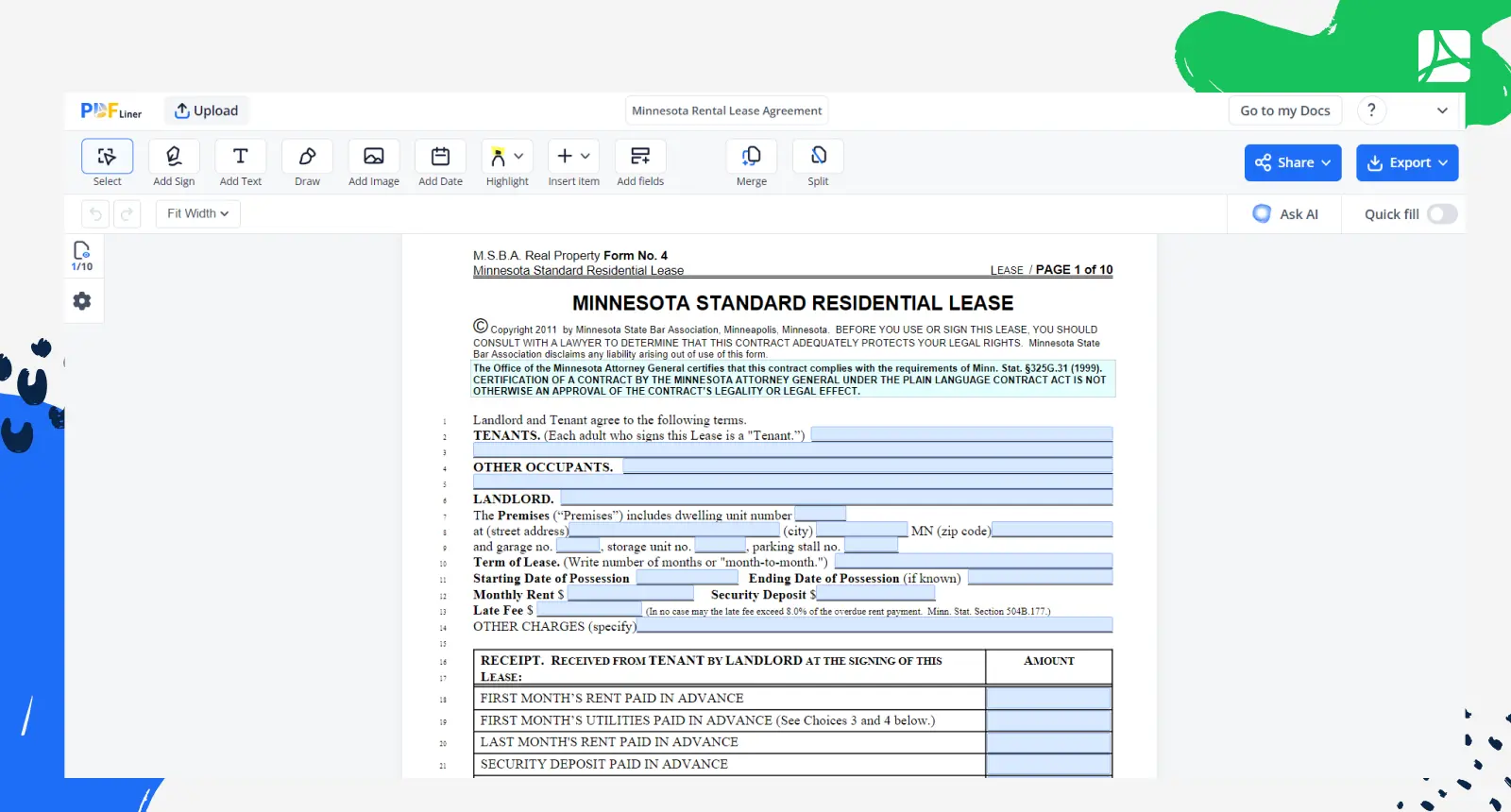-
Templates
1099 FormsAccurately report 1099 information returns and ensure IRS filing with easeExplore all templatesW-9 W-8 FormsEasily manage and share taxpayer details to streamline payments and meet IRS requirements with confidenceExplore all templatesOther Tax FormsFillable tax forms simplify and speed up your tax filing process and aid with recordkeeping.Explore all templatesReal EstateReal estate templates for all cases, from sale to rentals, save you a lot of time and effort.Explore all templatesLogisticsSimplify your trucking and logistics paperwork with our ready-to-use transportation and freight templates.Explore all templatesMedicalMedical forms help you keep patient documentation organized and secure.Explore all templatesBill of SaleBill of Sale templates streamline the transfer of ownership with clarity and protection.Explore all templatesContractsVarious contract templates ensure efficient and clear legal transactions.Explore all templatesEducationEducational forms and templates enhance the learning experience and student management.Explore all templates
-
Features
FeaturesAI-Enhanced Document Solutions for Contractor-Client Success and IRS ComplianceExplore all featuresAI Summarizer Check out the featureAI PDF summarizer makes your document workflow even faster. Ask AI to summarize PDF, assist you with tax forms, complete assignments, and more using just one tool.Sign PDF Check out the featurePDFLiner gives the opportunity to sign documents online, save them, send at once by email or print. Register now, upload your document and e-sign it onlineFill Out PDF Check out the featurePDFLiner provides different tools for filling in PDF forms. All you need is to register, upload the necessary document and start filling it out.Draw on a PDF Check out the featureDraw lines, circles, and other drawings on PDF using tools of PDFLiner online. Streamline your document editing process, speeding up your productivity
- Solutions
- Features
- Blog
- Support
- Pricing
- Log in
- Sign Up
Minnesota Rental Lease Agreement
Get your Minnesota Rental Lease Agreement in 3 easy steps
-
01 Fill and edit template
-
02 Sign it online
-
03 Export or print immediately
Understanding the Minnesota Rental Lease Agreement Form
A Minnesota rental lease agreement is a legally binding contract between a landlord and a tenant. This document outlines the terms and conditions of the rental, such as rental duration, rent amount, property rules, and actions that would constitute a breach of the agreement. Understanding what goes into a proper lease rental agreement Minnesota pdf can protect all parties involved in a renter-landlord transaction.

Key components of rental lease agreement Minnesota
Typically, a Minnesota rental lease agreement form includes the following components:
Information on Landlord and Tenant: As standard in any rental lease agreement in Minnesota, names and contact details of both parties should be included.
- Property Details: Clear specifications of the rented property should be stated. This can be as precise as the complete postal address, the floor of an apartment, and the accessories included (e.g., furniture, appliances).
- Lease Term: The duration of the lease should be specified, including the start and end dates.
- Rent and Payment Modalities: The rent amount, due date, and preferred payment method should be clearly defined.
- Deposit and Fees: Any requirement for security deposits, cleaning fees, or other possible charges should be enumerated and explained.
- Rules and Regulations: The landlord's rules about pets, noise levels, guests, and maintenance of the property must be stated.
- Termination Conditions: Grounds for terminations like repeated late rent payments, unlawful activities, or property damage beyond reasonable wear and tear.
How to Fill Out Minnesota Rental Lease Agreement
While filling out the lease rental agreement Minnesota pdf form may seem daunting, it doesn't have to be. Both landlords and tenants should read and understand each segment thoroughly, ensure all elements suit their agreement and keep a lookout for any omissions or sketchy clauses to prevent misunderstanding or possible conflict.
- In the 'Tenant' section, type the full legal name(s) of the person(s) who will be renting the property.
- The 'Other Occupants' section should include the names of any persons who will also be living in the rented property but are not signing the lease.
- In the 'Landlord' section, enter the name(s) of the property owner or the entity that manages the property.
- Properly specify the property's 'Address,' which includes the street, city, state, and zip code.
- For 'Term of Lease,' 'Starting Date of Possession,' and 'Ending Date of Possession,' provide the lease's length in months and the expected start and end dates.
- Under 'Monthly Rent $,' input the agreed upon monthly rent amount.
- Specify the amount of the 'Security Deposit $' that the tenant is required to pay prior to moving into the property.
- List any 'Late Fee $' that the tenant will incur if they fail to pay rent on time.
- If there are any 'Other Charges,' use this space and mark yes then write a brief description of what those charges are for.
- The 'Receipt' section should be filled out by the landlord, stating the amount they've initially received from the tenant.
- Mark whether 'Utilities' are 'Included in Rent,' or 'Not Included in Rent (Paid or Billed Separately).' Be sure to specify which utilities fall under each category.
- In 'Check All Appliances Included,' mark off all appliances that come with the rental property.
- Mark 'Smoking' as either 'Yes' or 'No' to indicate whether smoking is permitted in the rental property.
- Provide the contact details of the 'Person Authorized to Manage the Premises,' including their name, street address, city, state, zip, and phone number.
- The signature lines for the landlord, tenant, and if applicable, the agent acting on behalf of the landlord, should be completed with signatures and dates.
- Use the 'Additional Terms' section to list any extra agreements or conditions that are not covered in the standard lease agreement.
- In the 'Receipt By Tenant(s)' section, the tenant must acknowledge receipt of a copy of the lease.
Avoiding common mistakes
When dealing with a Minnesota rental lease agreement form, it's essential to dodge common pitfalls that can create misunderstandings or legal difficulties down the line. The following tips will help you prevent these common errors.
- Carefully Review All Clauses: Throughly review all the presented terms and conditions before signing. Ensure they are compliant with Minnesota rental laws to avoid unnecessary disputes. If anything seems vague or unclear, don't hesitate to request clarification.
- Failing to Document Property Condition: To protect your interests, ensure that the agreement includes a move-in inspection clause. This records the property's condition at the beginning of the lease term and serves as a reference at the end. Failing to do so may leave you vulnerable to unjustified damage claims.
- Overlooking Termination Clauses: Pay attention to the termination clause in your lease rental agreement. It should clearly state the acceptable grounds for terminating the lease, the notice period required, and any penalties that might apply. This ensures that both parties have a clear understanding of the circumstances under which the lease can be ended.
- Not Specifying Repair and Maintenance Responsibilities: Ensure the lease agreement clearly stipulates who is responsible for routine repairs and maintenance. This helps prevent disputes and ensures the property is kept in optimal condition.
- Forgetting to Save a Copy of the Agreement: Once signed, both the landlord and tenant should keep a copy of the lease agreement for reference. It could be vital in case of any disputes or misunderstandings.
Fillable online Minnesota Rental Lease Agreement


































































